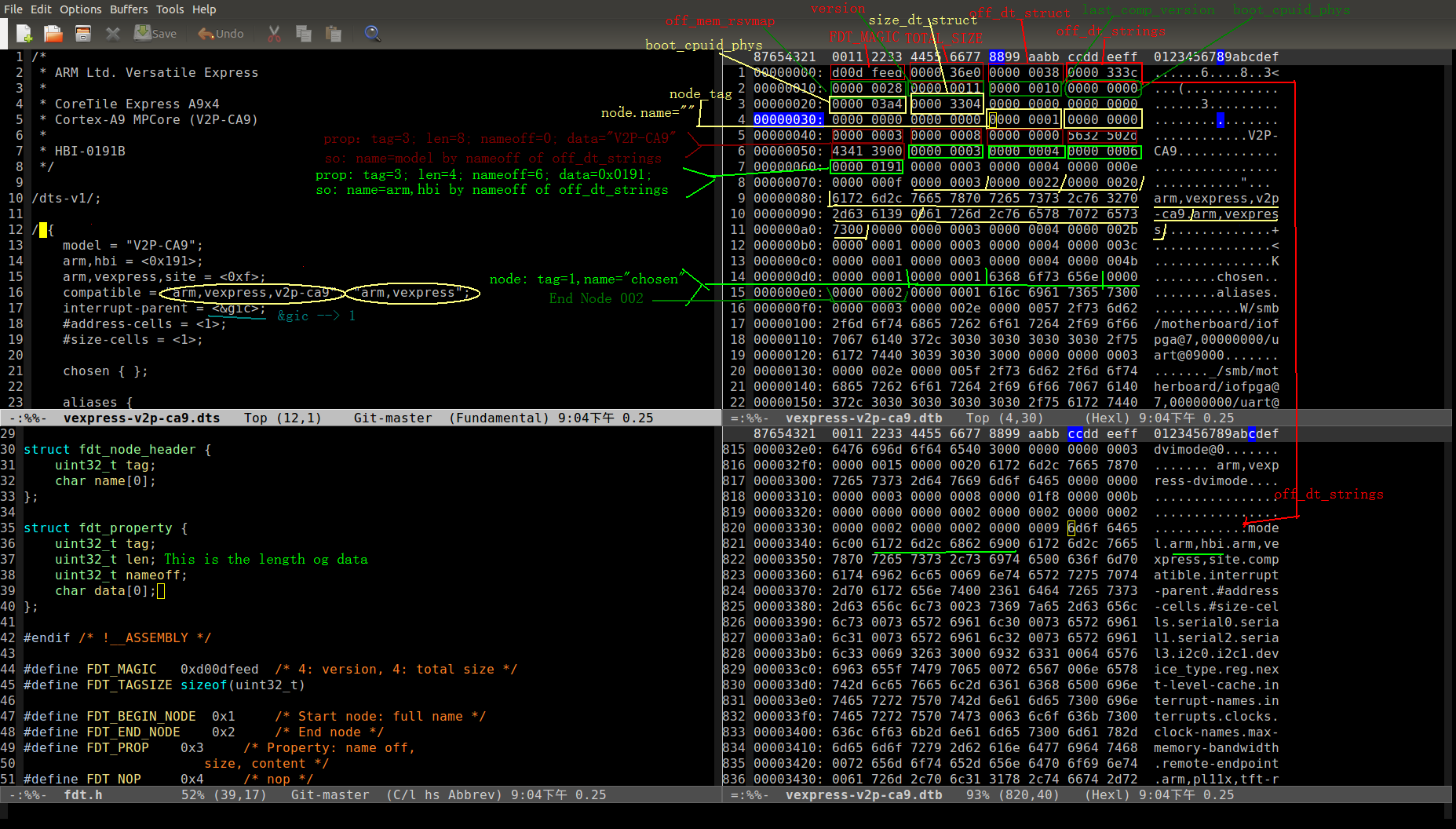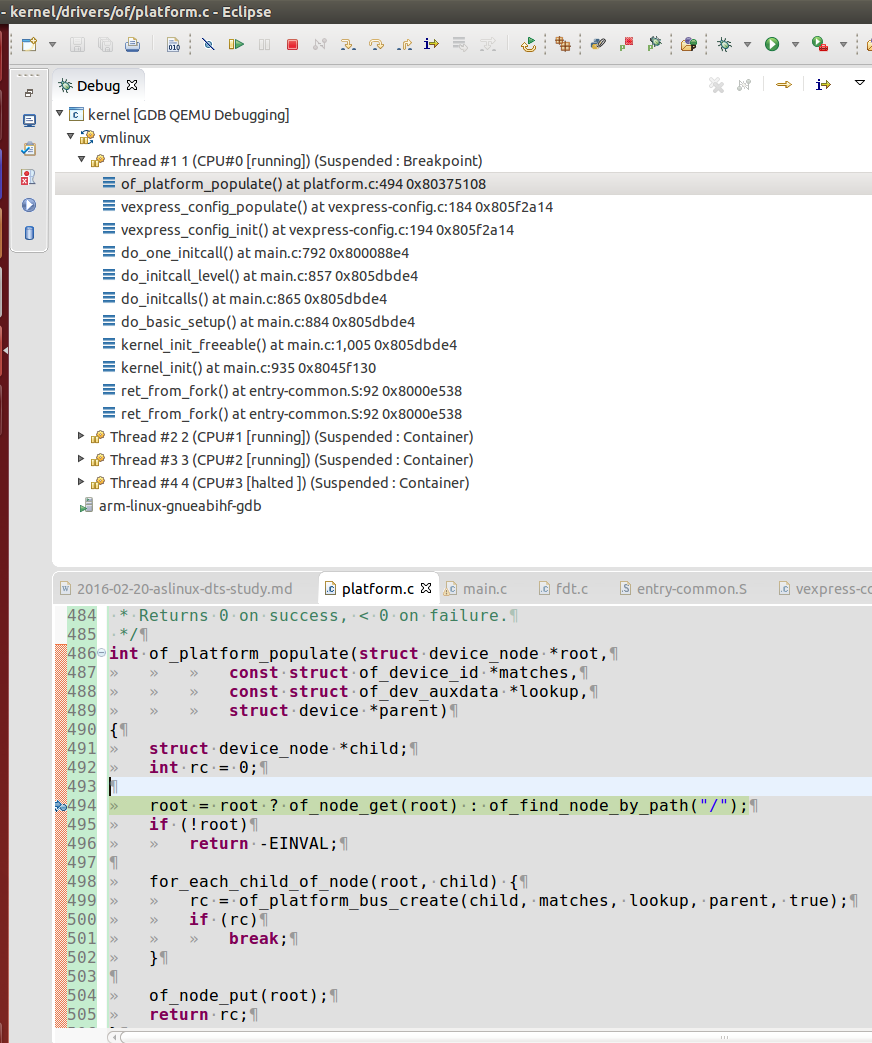aslinux DTS -- Device Tree System
unflatten_device_tree
Sometimes, I really want to give up, linux is so complex to me. But for the purpose to keep me valueable, I need to do it, though it is a tough things.
According to my opinion, if I want to know how to develop linux bsp, the first things that I need to know is linux DTS. So let me start. This article from csdn do give a basic introduction of linux DTS, you can read it firstly. so let’s use qemu and eclipse to debug it start_kernel() –> setup_arch() –> unflatten_device_tree().
/* kernel/drivers/okernel/drivers/of/fdt.c */
void __init unflatten_device_tree(void)
{
__unflatten_device_tree(initial_boot_params, &of_allnodes,
early_init_dt_alloc_memory_arch);
/* Get pointer to "/chosen" and "/aliases" nodes for use everywhere */
of_alias_scan(early_init_dt_alloc_memory_arch);
}
look into the code of function __unflatten_device_tree, it will firstly check the header of the blob(initial_boot_params).
#define FDT_MAGIC 0xd00dfeed /* 4: version, 4: total size */
#define FDT_FIRST_SUPPORTED_VERSION 0x10
#define FDT_LAST_SUPPORTED_VERSION 0x11
#define FDT_SW_MAGIC (~FDT_MAGIC)
struct fdt_header {
uint32_t magic; /* magic word FDT_MAGIC */
uint32_t totalsize; /* total size of DT block */
uint32_t off_dt_struct; /* offset to structure */
uint32_t off_dt_strings; /* offset to strings */
uint32_t off_mem_rsvmap; /* offset to memory reserve map */
uint32_t version; /* format version */
uint32_t last_comp_version; /* last compatible version */
/* version 2 fields below */
uint32_t boot_cpuid_phys; /* Which physical CPU id we're
booting on */
/* version 3 fields below */
uint32_t size_dt_strings; /* size of the strings block */
/* version 17 fields below */
uint32_t size_dt_struct; /* size of the structure block */
};
int fdt_check_header(const void *fdt)
{
if (fdt_magic(fdt) == FDT_MAGIC) {
/* Complete tree */
if (fdt_version(fdt) < FDT_FIRST_SUPPORTED_VERSION)
return -FDT_ERR_BADVERSION;
if (fdt_last_comp_version(fdt) > FDT_LAST_SUPPORTED_VERSION)
return -FDT_ERR_BADVERSION;
} else if (fdt_magic(fdt) == FDT_SW_MAGIC) {
/* Unfinished sequential-write blob */
if (fdt_size_dt_struct(fdt) == 0)
return -FDT_ERR_BADSTATE;
} else {
return -FDT_ERR_BADMAGIC;
}
return 0;
}
OK, here let’s use the Emacs open the dtb file vexpress-v2p-ca9.dtb, and display in hexl-mode,below is the part of header. As you could see that the first 4 bytes value is 0xd00dfeed which is just the value of macro FDT_MAGIC. And then accoring to the fdt_header structure, we can easily know that the dtb version is 0x11 and the last compatible version is 0x10, so that the header check will pass and return value 0. And the totalsize is 0x36e0(14048), you can check that the size is the same with file vexpress-v2p-ca9.dtb.
vexpress-v2p-ca9.dtb
00000000: d00d feed 0000 36e0 0000 0038 0000 333c ......6....8..3<
00000010: 0000 0028 0000 0011 0000 0010 0000 0000 ...(............
00000020: 0000 03a4 0000 3304 0000 0000 0000 0000 ......3.........
00000030: 0000 0000 0000 0000 0000 0001 0000 0000 ................
00000040: 0000 0003 0000 0008 0000 0000 5632 502d ............V2P-
00000050: 4341 3900 0000 0003 0000 0004 0000 0006 CA9.............
00000060: 0000 0191 0000 0003 0000 0004 0000 000e ................
00000070: 0000 000f 0000 0003 0000 0022 0000 0020 ..........."...
00000080: 6172 6d2c 7665 7870 7265 7373 2c76 3270 arm,vexpress,v2p
00000090: 2d63 6139 0061 726d 2c76 6578 7072 6573 -ca9.arm,vexpres
000000a0: 7300 0000 0000 0003 0000 0004 0000 002b s..............+
000000b0: 0000 0001 0000 0003 0000 0004 0000 003c ...............<
000000c0: 0000 0001 0000 0003 0000 0004 0000 004b ...............K
000000d0: 0000 0001 0000 0001 6368 6f73 656e 0000 ........chosen..
000000e0: 0000 0002 0000 0001 616c 6961 7365 7300 ........aliases.
000000f0: 0000 0003 0000 002e 0000 0057 2f73 6d62 ...........W/smb
00000100: 2f6d 6f74 6865 7262 6f61 7264 2f69 6f66 /motherboard/iof
00000110: 7067 6140 372c 3030 3030 3030 3030 2f75 pga@7,00000000/u
00000120: 6172 7440 3039 3030 3000 0000 0000 0003 art@09000.......
OK, then on offset of stucture is 0x38, offset to strings is 0x333C, so locate to address 0x333c by ^M g, you will find a text message, but now I don’t understand, below is part of it. The offset to memory reserve map is 0x03a4, OK, not understood by me now.
00003330: 0000 0002 0000 0002 0000 0009 6d6f 6465 ............mode
00003340: 6c00 6172 6d2c 6862 6900 6172 6d2c 7665 l.arm,hbi.arm,ve
00003350: 7870 7265 7373 2c73 6974 6500 636f 6d70 xpress,site.comp
00003360: 6174 6962 6c65 0069 6e74 6572 7275 7074 atible.interrupt
00003370: 2d70 6172 656e 7400 2361 6464 7265 7373 -parent.#address
00003380: 2d63 656c 6c73 0023 7369 7a65 2d63 656c -cells.#size-cel
00003390: 6c73 0073 6572 6961 6c30 0073 6572 6961 ls.serial0.seria
go on, reading, the next API of __unflatten_device_tree is unflatten_dt_node, it is very long. The first action is the fdt_get_name, here it do check the header again, and then check the node offset, and see there is structure fdt_node_header, I think it would be the key point to know what is dtb. from the above analyse, we will know the nh will point to the offset 0x38,the tag would be 1(FDT_BEGIN_NODE), the name would be empty, that is the start node, wonderfull.
#define FDT_BEGIN_NODE 0x1 /* Start node: full name */
#define FDT_END_NODE 0x2 /* End node */
#define FDT_PROP 0x3 /* Property: name off,
size, content */
#define FDT_NOP 0x4 /* nop */
#define FDT_END 0x9
struct fdt_node_header {
uint32_t tag;
char name[0];
};
static inline const void *_fdt_offset_ptr(const void *fdt, int offset)
{
return (const char *)fdt + fdt_off_dt_struct(fdt) + offset;
}
const char *fdt_get_name(const void *fdt, int nodeoffset, int *len)
{
const struct fdt_node_header *nh = _fdt_offset_ptr(fdt, nodeoffset);
int err;
if (((err = fdt_check_header(fdt)) != 0)
|| ((err = _fdt_check_node_offset(fdt, nodeoffset)) < 0))
goto fail;
if (len)
*len = strlen(nh->name);
return nh->name;
fail:
if (len)
*len = err;
return NULL;
}
okay, go back to API unflatten_dt_node, check the following code, wow, all is OK, the pathp=”” will go through the first if branch so that a root node would be made.
/* version 0x10 has a more compact unit name here instead of the full
* path. we accumulate the full path size using "fpsize", we'll rebuild
* it later. We detect this because the first character of the name is
* not '/'.
*/
if ((*pathp) != '/') {
new_format = 1;
if (fpsize == 0) {
/* root node: special case. fpsize accounts for path
* plus terminating zero. root node only has '/', so
* fpsize should be 2, but we want to avoid the first
* level nodes to have two '/' so we use fpsize 1 here
*/
fpsize = 1;
allocl = 2;
l = 1;
pathp = "";
} else {
/* account for '/' and path size minus terminal 0
* already in 'l'
*/
fpsize += l;
allocl = fpsize;
}
}
then on, a for loop to set up the node’s properties, okay, as above analyse, we know a property node will with tag FDT_PROP 3, so that by the information of structure fdt_property, it will be possible to loop all its properties.
struct fdt_property {
uint32_t tag;
uint32_t len;
uint32_t nameoff;
char data[0];
};
/* process properties */
for (offset = fdt_first_property_offset(blob, *poffset);
(offset >= 0);
(offset = fdt_next_property_offset(blob, offset))) {
const char *pname;
u32 sz;
if (!(p = fdt_getprop_by_offset(blob, offset, &pname, &sz))) {
offset = -FDT_ERR_INTERNAL;
break;
}
if (pname == NULL) {
pr_info("Can't find property name in list !\n");
break;
}
if (strcmp(pname, "name") == 0)
has_name = 1;
pp = unflatten_dt_alloc(&mem, sizeof(struct property),
__alignof__(struct property));
if (allnextpp) {
/* We accept flattened tree phandles either in
* ePAPR-style "phandle" properties, or the
* legacy "linux,phandle" properties. If both
* appear and have different values, things
* will get weird. Don't do that. */
if ((strcmp(pname, "phandle") == 0) ||
(strcmp(pname, "linux,phandle") == 0)) {
if (np->phandle == 0)
np->phandle = be32_to_cpup(p);
}
/* And we process the "ibm,phandle" property
* used in pSeries dynamic device tree
* stuff */
if (strcmp(pname, "ibm,phandle") == 0)
np->phandle = be32_to_cpup(p);
pp->name = (char *)pname;
pp->length = sz;
pp->value = (__be32 *)p;
*prev_pp = pp;
prev_pp = &pp->next;
}
}
this picture below gives a simple overview about how a DTB was parsed by linux kernel, so I know that the dtb will be copied to the RAM by uboot and passed to kernel as paramter and then parsed by the kernel. And the name of the node or property can be any valid string I think, that’s great, by now I know how the DTS was parsed by the kernel, so next step is that how the DTS was used by the kernel.

###of_platform_populate then on the key API of_platform_populate which will do the post process of the DTS which has been parsed by the above analyze. by qemu debuger with eclipse, I could easily know how the API was called as the below picture showed:

so that we could know that this API of_platform_populate is called by the kernel postcore_initcall function vexpress_config_init, and with qemu eclipse debuger, you could also that there is other initialization API such as vexpress_sysreg_base will call API of_find_compatible_node to initialize the node device.
*** kernel/drivers/bus/vexpress-config.c
static int __init vexpress_config_init(void)
{
int err = 0;
struct device_node *node;
/* Need the config devices early, before the "normal" devices... */
for_each_compatible_node(node, NULL, "arm,vexpress,config-bus") {
err = vexpress_config_populate(node);
if (err)
break;
}
return err;
}
postcore_initcall(vexpress_config_init);
*** kernel/drivers/mfd/vexpress-sysreg.c
static void __iomem *vexpress_sysreg_base(void)
{
if (!__vexpress_sysreg_base) {
struct device_node *node = of_find_compatible_node(NULL, NULL,
"arm,vexpress-sysreg");
__vexpress_sysreg_base = of_iomap(node, 0);
}
WARN_ON(!__vexpress_sysreg_base);
return __vexpress_sysreg_base;
}
*** kernel/drivers/of/base.c
struct device_node *of_find_compatible_node(struct device_node *from,
const char *type, const char *compatible)
{
struct device_node *np;
unsigned long flags;
raw_spin_lock_irqsave(&devtree_lock, flags);
np = from ? from->allnext : of_allnodes;
for (; np; np = np->allnext) {
if (__of_device_is_compatible(np, compatible, type, NULL) &&
of_node_get(np))
break;
}
of_node_put(from);
raw_spin_unlock_irqrestore(&devtree_lock, flags);
return np;
}
EXPORT_SYMBOL(of_find_compatible_node);
*** kernel/drivers/of/platform.c
int of_platform_populate(struct device_node *root,
const struct of_device_id *matches,
const struct of_dev_auxdata *lookup,
struct device *parent)
{
struct device_node *child;
int rc = 0;
root = root ? of_node_get(root) : of_find_node_by_path("/");
if (!root)
return -EINVAL;
for_each_child_of_node(root, child) {
rc = of_platform_bus_create(child, matches, lookup, parent, true);
if (rc)
break;
}
of_node_put(root);
return rc;
}
so that till now, generally, we could know how a device board specific information was passed to kernel by the DTB, so I think next step is that to do analyze of one of the vexpress drivers.
